Dahong Qian
SPRMamba: Surgical Phase Recognition for Endoscopic Submucosal Dissection with Mamba
Sep 18, 2024



Abstract:Endoscopic Submucosal Dissection (ESD) is a minimally invasive procedure initially designed for the treatment of early gastric cancer but is now widely used for various gastrointestinal lesions. Computer-assisted Surgery systems have played a crucial role in improving the precision and safety of ESD procedures, however, their effectiveness is limited by the accurate recognition of surgical phases. The intricate nature of ESD, with different lesion characteristics and tissue structures, presents challenges for real-time surgical phase recognition algorithms. Existing surgical phase recognition algorithms struggle to efficiently capture temporal contexts in video-based scenarios, leading to insufficient performance. To address these issues, we propose SPRMamba, a novel Mamba-based framework for ESD surgical phase recognition. SPRMamba leverages the strengths of Mamba for long-term temporal modeling while introducing the Scaled Residual TranMamba block to enhance the capture of fine-grained details, overcoming the limitations of traditional temporal models like Temporal Convolutional Networks and Transformers. Moreover, a Temporal Sample Strategy is introduced to accelerate the processing, which is essential for real-time phase recognition in clinical settings. Extensive testing on the ESD385 dataset and the cholecystectomy Cholec80 dataset demonstrates that SPRMamba surpasses existing state-of-the-art methods and exhibits greater robustness across various surgical phase recognition tasks.
Deep Multimodal Collaborative Learning for Polyp Re-Identification
Aug 12, 2024Abstract:Colonoscopic Polyp Re-Identification aims to match the same polyp from a large gallery with images from different views taken using different cameras and plays an important role in the prevention and treatment of colorectal cancer in computer-aided diagnosis. However, traditional methods for object ReID directly adopting CNN models trained on the ImageNet dataset usually produce unsatisfactory retrieval performance on colonoscopic datasets due to the large domain gap. Worsely, these solutions typically learn unimodal modal representations on the basis of visual samples, which fails to explore complementary information from different modalities. To address this challenge, we propose a novel Deep Multimodal Collaborative Learning framework named DMCL for polyp re-identification, which can effectively encourage modality collaboration and reinforce generalization capability in medical scenarios. On the basis of it, a dynamic multimodal feature fusion strategy is introduced to leverage the optimized multimodal representations for multimodal fusion via end-to-end training. Experiments on the standard benchmarks show the benefits of the multimodal setting over state-of-the-art unimodal ReID models, especially when combined with the specialized multimodal fusion strategy.
PredIN: Towards Open-Set Gesture Recognition via Prediction Inconsistency
Jul 29, 2024Abstract:Gesture recognition based on surface electromyography (sEMG) has achieved significant progress in human-machine interaction (HMI). However, accurately recognizing predefined gestures within a closed set is still inadequate in practice; a robust open-set system needs to effectively reject unknown gestures while correctly classifying known ones. To handle this challenge, we first report prediction inconsistency discovered for unknown classes due to ensemble diversity, which can significantly facilitate the detection of unknown classes. Based on this insight, we propose an ensemble learning approach, PredIN, to explicitly magnify the prediction inconsistency by enhancing ensemble diversity. Specifically, PredIN maximizes the class feature distribution inconsistency among ensemble members to enhance diversity. Meanwhile, it optimizes inter-class separability within an individual ensemble member to maintain individual performance. Comprehensive experiments on various benchmark datasets demonstrate that the PredIN outperforms state-of-the-art methods by a clear margin.Our proposed method simultaneously achieves accurate closed-set classification for predefined gestures and effective rejection for unknown gestures, exhibiting its efficacy and superiority in open-set gesture recognition based on sEMG.
STS MICCAI 2023 Challenge: Grand challenge on 2D and 3D semi-supervised tooth segmentation
Jul 18, 2024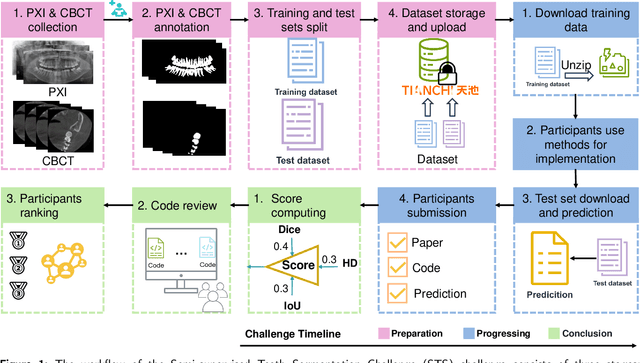


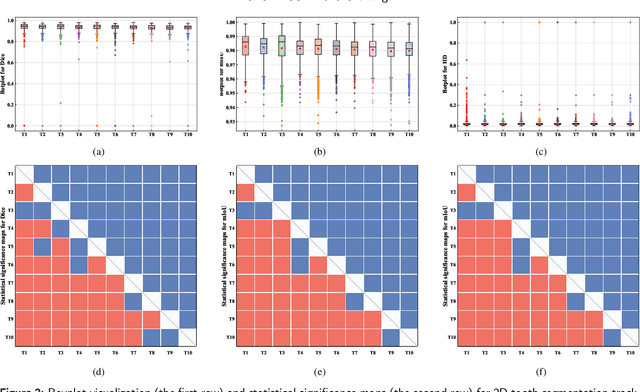
Abstract:Computer-aided design (CAD) tools are increasingly popular in modern dental practice, particularly for treatment planning or comprehensive prognosis evaluation. In particular, the 2D panoramic X-ray image efficiently detects invisible caries, impacted teeth and supernumerary teeth in children, while the 3D dental cone beam computed tomography (CBCT) is widely used in orthodontics and endodontics due to its low radiation dose. However, there is no open-access 2D public dataset for children's teeth and no open 3D dental CBCT dataset, which limits the development of automatic algorithms for segmenting teeth and analyzing diseases. The Semi-supervised Teeth Segmentation (STS) Challenge, a pioneering event in tooth segmentation, was held as a part of the MICCAI 2023 ToothFairy Workshop on the Alibaba Tianchi platform. This challenge aims to investigate effective semi-supervised tooth segmentation algorithms to advance the field of dentistry. In this challenge, we provide two modalities including the 2D panoramic X-ray images and the 3D CBCT tooth volumes. In Task 1, the goal was to segment tooth regions in panoramic X-ray images of both adult and pediatric teeth. Task 2 involved segmenting tooth sections using CBCT volumes. Limited labelled images with mostly unlabelled ones were provided in this challenge prompt using semi-supervised algorithms for training. In the preliminary round, the challenge received registration and result submission by 434 teams, with 64 advancing to the final round. This paper summarizes the diverse methods employed by the top-ranking teams in the STS MICCAI 2023 Challenge.
EDPNet: An Efficient Dual Prototype Network for Motor Imagery EEG Decoding
Jul 03, 2024Abstract:Motor imagery electroencephalograph (MI-EEG) decoding plays a crucial role in developing motor imagery brain-computer interfaces (MI-BCIs). However, decoding intentions from MI remains challenging due to the inherent complexity of EEG signals relative to the small-sample size. In this paper, we propose an Efficient Dual Prototype Network (EDPNet) to enable accurate and fast MI decoding. EDPNet employs a lightweight adaptive spatial-spectral fusion module, which promotes more efficient information fusion between multiple EEG electrodes. Subsequently, a parameter-free multi-scale variance pooling module extracts more comprehensive temporal features. Furthermore, we introduce dual prototypical learning to optimize the feature space distribution and training process, thereby improving the model's generalization ability on small-sample MI datasets. Our experimental results show that the EDPNet outperforms state-of-the-art models with superior classification accuracy and kappa values (84.11% and 0.7881 for dataset BCI competition IV 2a, 86.65% and 0.7330 for dataset BCI competition IV 2b). Additionally, we use the BCI competition III IVa dataset with fewer training data to further validate the generalization ability of the proposed EDPNet. We also achieve superior performance with 82.03% classification accuracy. Benefiting from the lightweight parameters and superior decoding accuracy, our EDPNet shows great potential for MI-BCI applications. The code is publicly available at https://github.com/hancan16/EDPNet.
Hybrid 3D Human Pose Estimation with Monocular Video and Sparse IMUs
Apr 27, 2024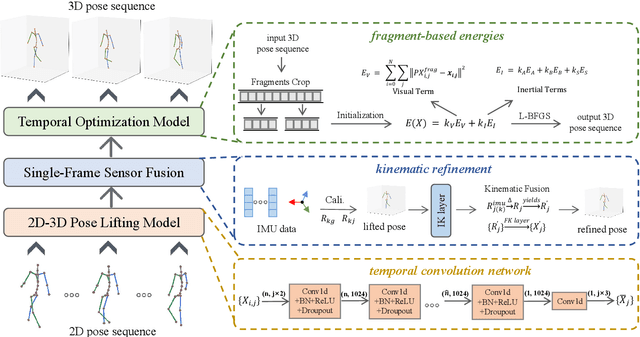

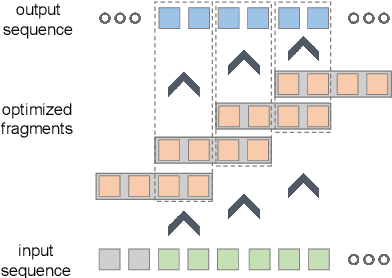

Abstract:Temporal 3D human pose estimation from monocular videos is a challenging task in human-centered computer vision due to the depth ambiguity of 2D-to-3D lifting. To improve accuracy and address occlusion issues, inertial sensor has been introduced to provide complementary source of information. However, it remains challenging to integrate heterogeneous sensor data for producing physically rational 3D human poses. In this paper, we propose a novel framework, Real-time Optimization and Fusion (RTOF), to address this issue. We first incorporate sparse inertial orientations into a parametric human skeleton to refine 3D poses in kinematics. The poses are then optimized by energy functions built on both visual and inertial observations to reduce the temporal jitters. Our framework outputs smooth and biomechanically plausible human motion. Comprehensive experiments with ablation studies demonstrate its rationality and efficiency. On Total Capture dataset, the pose estimation error is significantly decreased compared to the baseline method.
Skeleton-Guided Instance Separation for Fine-Grained Segmentation in Microscopy
Jan 19, 2024



Abstract:One of the fundamental challenges in microscopy (MS) image analysis is instance segmentation (IS), particularly when segmenting cluster regions where multiple objects of varying sizes and shapes may be connected or even overlapped in arbitrary orientations. Existing IS methods usually fail in handling such scenarios, as they rely on coarse instance representations such as keypoints and horizontal bounding boxes (h-bboxes). In this paper, we propose a novel one-stage framework named A2B-IS to address this challenge and enhance the accuracy of IS in MS images. Our approach represents each instance with a pixel-level mask map and a rotated bounding box (r-bbox). Unlike two-stage methods that use box proposals for segmentations, our method decouples mask and box predictions, enabling simultaneous processing to streamline the model pipeline. Additionally, we introduce a Gaussian skeleton map to aid the IS task in two key ways: (1) It guides anchor placement, reducing computational costs while improving the model's capacity to learn RoI-aware features by filtering out noise from background regions. (2) It ensures accurate isolation of densely packed instances by rectifying erroneous box predictions near instance boundaries. To further enhance the performance, we integrate two modules into the framework: (1) An Atrous Attention Block (A2B) designed to extract high-resolution feature maps with fine-grained multiscale information, and (2) A Semi-Supervised Learning (SSL) strategy that leverages both labeled and unlabeled images for model training. Our method has been thoroughly validated on two large-scale MS datasets, demonstrating its superiority over most state-of-the-art approaches.
Supervised Contrastive Learning for Fine-grained Chromosome Recognition
Dec 12, 2023Abstract:Chromosome recognition is an essential task in karyotyping, which plays a vital role in birth defect diagnosis and biomedical research. However, existing classification methods face significant challenges due to the inter-class similarity and intra-class variation of chromosomes. To address this issue, we propose a supervised contrastive learning strategy that is tailored to train model-agnostic deep networks for reliable chromosome classification. This method enables extracting fine-grained chromosomal embeddings in latent space. These embeddings effectively expand inter-class boundaries and reduce intra-class variations, enhancing their distinctiveness in predicting chromosome types. On top of two large-scale chromosome datasets, we comprehensively validate the power of our contrastive learning strategy in boosting cutting-edge deep networks such as Transformers and ResNets. Extensive results demonstrate that it can significantly improve models' generalization performance, with an accuracy improvement up to +4.5%. Codes and pretrained models will be released upon acceptance of this work.
Towards Open-set Gesture Recognition via Feature Activation Enhancement and Orthogonal Prototype Learning
Dec 05, 2023Abstract:Gesture recognition is a foundational task in human-machine interaction (HMI). While there has been significant progress in gesture recognition based on surface electromyography (sEMG), accurate recognition of predefined gestures only within a closed set is still inadequate in practice. It is essential to effectively discern and reject unknown gestures of disinterest in a robust system. Numerous methods based on prototype learning (PL) have been proposed to tackle this open set recognition (OSR) problem. However, they do not fully explore the inherent distinctions between known and unknown classes. In this paper, we propose a more effective PL method leveraging two novel and inherent distinctions, feature activation level and projection inconsistency. Specifically, the Feature Activation Enhancement Mechanism (FAEM) widens the gap in feature activation values between known and unknown classes. Furthermore, we introduce Orthogonal Prototype Learning (OPL) to construct multiple perspectives. OPL acts to project a sample from orthogonal directions to maximize the distinction between its two projections, where unknown samples will be projected near the clusters of different known classes while known samples still maintain intra-class similarity. Our proposed method simultaneously achieves accurate closed-set classification for predefined gestures and effective rejection for unknown gestures. Extensive experiments demonstrate its efficacy and superiority in open-set gesture recognition based on sEMG.
Towards Discriminative Representation with Meta-learning for Colonoscopic Polyp Re-Identification
Aug 02, 2023

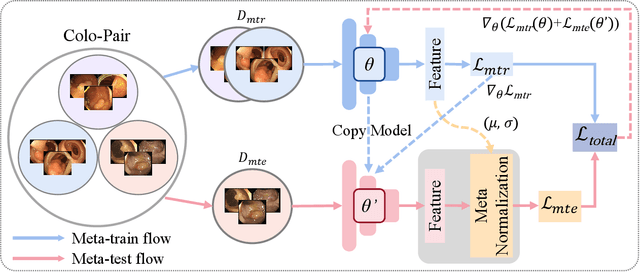

Abstract:Colonoscopic Polyp Re-Identification aims to match the same polyp from a large gallery with images from different views taken using different cameras and plays an important role in the prevention and treatment of colorectal cancer in computer-aided diagnosis. However, traditional methods for object ReID directly adopting CNN models trained on the ImageNet dataset usually produce unsatisfactory retrieval performance on colonoscopic datasets due to the large domain gap. Additionally, these methods neglect to explore the potential of self-discrepancy among intra-class relations in the colonoscopic polyp dataset, which remains an open research problem in the medical community. To solve this dilemma, we propose a simple but effective training method named Colo-ReID, which can help our model to learn more general and discriminative knowledge based on the meta-learning strategy in scenarios with fewer samples. Based on this, a dynamic Meta-Learning Regulation mechanism called MLR is introduced to further boost the performance of polyp re-identification. To the best of our knowledge, this is the first attempt to leverage the meta-learning paradigm instead of traditional machine learning to effectively train deep models in the task of colonoscopic polyp re-identification. Empirical results show that our method significantly outperforms current state-of-the-art methods by a clear margin.
 Add to Chrome
Add to Chrome Add to Firefox
Add to Firefox Add to Edge
Add to Edge